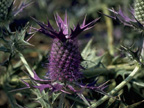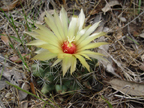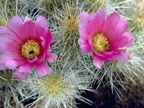Scientific Field Trips |
||
FT
1 - B & B
- Botany and Barbeque - Palmetto State Park In 1831, the Mexican government sent a six-pound cannon to Gonzales as protection against the Indians. This cannon was used in the “Come and Take It” Battle on October 2, 1835, when the first shot of the Texas Revolution was fired. A few months after the first shot, men and boys from the region gathered in Gonzales and sent the only reinforcements ever received at the Alamo. In a State known for outstanding barbeque, few places can surpass Kreuz Market, located in Lockhart. For lunch you will enjoy beef brisket, pork chops, sausage, and(or) ribs served on elegant sheets of butcher paper. Water will be provided for the Palmetto State Park visit. You should bring a pack, sunscreen and insect repellent, and wear comfortable walking shoes, a hat, and sunglasses. Birders might want to bring binoculars, and don’t forget your camera. El Marko Note: You might need a brewski or twoski to “warsh that BBQ on down” and a lot of soap and water when you’re done to “rinch your hands.” FT
2 Useful Wild Plants of McKinney Falls State Park Sunday,
August 14 - 8:00 am – 4:00
pm FT 4 Central Texas
Spring-Fed Rivers: From Lindheimer's Paradise to Endangered
Species
Sunday, August 14, 9:00 am – 4:00 pm Jackie M. Poole, Texas Parks & Wildlife Dept, Email: Jackie.Poole@tpwd.state.tx.us Limit: 20 Lunch: on your own Large spring-fed rivers between Austin and San Antonio are important to Texas botany: the "Father of Texas botany", Ferdinand Lindheimer, lived on the banks of one (the Guadalupe River at New Braunfels), and the very rare Texas wild rice (Zizania texana) continues to hold on in another (the Comal River, at San Marcos). They are also a great place to cool off on a Texas summer afternoon.This field trip, led by Texas Parks & Wildlife Dept. rare plant botanist Jackie Poole, will first go to New Braunfels to visit the Lindheimer Home, where Lindheimer lived for decades in the 1800s while botanizing and publishing the local German-language newspaper. Then, following an early lunch, the group will proceed to the San Marcos River to "tube" the uppermost part just below the springs. ("Tubing" is floating down the river in inner tubes, in swimming suits.) You'll get to see Zizania texana and other aquatics while Jackie explains the ecology and multiple conservation problems of aquifer-fed aquatic ecosystems in central Texas and the specific problems of the Texas wild rice. Bring swimming suits or shorts, T-shirt, and (extra) shoes you can get wet and dirty for tubing (these are necessary!), and sun protection (sunscreen, hat, and/or wet-able shirt etc.); rustic clothes-changing facilities are available at tube-rental. Water will be provided. FT 5 Blanco River Botany – Central Texas limestone endemic Sunday, August 14, 8:00 am – 4:00 pm Bill Carr, The Nature Conservancy of Texas; Email: arr@tnc.org Limit: 10 Lunch: on own Nature Conservancy botanist Bill Carr will lead a small group onto the private Halifax Ranch along the Blanco River in Blanco County. This 3300-acre ranch is home to about 400 plant taxa, including 17 Texas endemics, 1 globally-rare (G2) shrub, 6 quasi-rare (G3) taxa), and at least 10 oddball disjuncts / regional rarities. The area includes typical upland Edwards Plateau vegetation on limestone, but of especial interest are the lovely canyons along and near the Blanco River. Major habitats include mesic limestone canyons, xeric south-facing cliff faces, spring / seep zones, and sandy river terraces /gravel bars maintained by a major flood-prone stream. The hike will not be strenuous and will be mostly in the morning, but heat can nonetheless be intense, so hats, sunscreen, and a small daypack to carry water (provided) will be needed. Footware appropriate for rough, rocky terrain should be worn, but walking shorts will be OK. There will be the opportunity to cool off in the river near the end of the walk for those so inclined. Lunch will follow at a typical Texas barbecue restaurant (vegetarian available) before returning to Austin mid-afternoon. FT
6 Balcones Canyonlands Limestone Grotto and Canyon Flora:
Hamilton Pool and West Cave FT
7 Early Tertiary Floras of Central Texas FT
8 Ferns of the Central Texas Area
Sunday, August 14, 7:00 am – 5:00 pm Jim Blassingame, South Plains College; Email: Laura.L.Sanchez@us.army.mil Jack Stanford, Howard Payne College, Laura Sánchez, Natural Resources Fort Hood Limit: 25 Lunch: Box Lunch We will visit two sites representing two different ecoregions in the central Texas area. Our first stop will be Inks Lake State Park, in the Llano Uplift region. This is an area of pink granite outcroppings with a unique flora. Some species that we will see here include Astrolepis sinuata, Cheilanthes lindheimeri, Cheilanthes tomentosa, Pellaea ovata, Pellaea wrightiana, Isoetes lithophila, Isoetes melanopoda, Selaginella arenicola, Selaginella peruviana, and Woodsia obtusa. After lunch we will go on a tour of West Cave Preserve, which is in the Canyonlands of the Edwards Plateau. At West Cave, we will visit a sheltered limestone canyon that has a 40 foot waterfall. Some species that we will see here include Adiantum capillus-veneris, Anemia mexicana, Argyrochosma dealbata, Cheilanthes alabamensis, and Thelypteris ovata. You will need to wear sturdy shoes and bring a hat, sunscreen, and insect repellant, and a small day pack to carry water, which will be provided. FT 9 Bryophytes and Lichens of the Texas Hill Country Sunday, August 14, 7:30 am – 5:00 pm Ann Rushing, Baylor University; Email: Ann_Rushing@baylor.edu Bob Egan, University of Nebraska at Omaha Limit: 25 Lunch: Box Lunch On this full day field trip, sponsored by the American Bryological and Lichenological Society, we will travel by bus to various localities near Austin representative of central Texas habitats, including Bastrop State Park and Hamilton Pool County Park. Bryophytes and lichens will both be observed during the trip. Limited collecting may be permitted in state parks. Temperatures in Texas in August may reach 100F by mid-afternoon. Participants should bring sunscreen and wear comfortable hiking shoes and cool clothing. FT
10 Jewel of the Post Oak Belt: Bogs and Xeric Sands of the
Gus Engeling WMA FT
11 Wild Basin Wilderness Preserve Tuesday, August 16 8:00 am – 12:00 noon Damon Waitt, Lady Bird Johnson Wildflower Center; Email: dwaitt@wildflower.org Limit: 30 Lunch: No
Founded
in 1982 by Lady Bird Johnson and the late Helen Hayes, the Lady Bird Johnson
Wildflower
Center is dedicated to protecting and preserving North America’s native
plants and natural landscapes. The mission of the Wildflower Center is to educate
people about the environmental necessity, economic value, and natural beauty
of native plants. The grounds include several hundred species of plants native
to the Edward’s Plateau in naturalistic, traditional and formal designs,
and one and a half miles of interpretive trails through an oak-juniper savanna
and ecological restoration laboratory.
Your behind scenes tour will be led by three of the Wildflower Center’s senior staff: Dr. Damon Waitt, Senior Botanist and Director of the National Plant Information Network, Dr. Steve Windhager, Director of Landscape Restoration, and Flo Oxley, Education Director and Conservation Scientist. Water will be provided. You should bring sunscreen and insect repellent, and wear comfortable walking shoes, a hat, and sunglasses. Birders might want to bring binoculars, and don’t forget your camera.
FT
13 A Brief Introduction to the Balcones Escarpment Flora: Balcones Canyonland
Preserve Austin spreads out directly over the Balcones Fault, the ancient and inactive geological fault that forms the eastern edge of the Edwards Plateau, and the resultant escarpment is called the Balcones Escarpment or Balcones Canyonlands. The canyons of this area harbor a fascinating combination of endemic, disjunct, and widespread species that add to the already unique Edwards Plateau flora of surrounding uplands and the karst caves that are home to a number of endemic invertebrates. The Balcones Canyonlands Preserve is an extensive coordinated patchwork of preserved land owned by public and private entities including the City of Austin, Travis County, Lower Colorado River Authority, Nature Conservancy of Texas, Travis Audubon Society, as well as private landowners, and is one of the country's largest urban/suburban preserves; many of its lands, including the area visited on this trip (owned by Travis County), can be visited only by previous arrangement. We will walk
through an excellent example of a limestone canyon, enjoying the beautiful
canyon woodland while seeing endemic plants and discussing the role of the
Preserve in this rapidly growing urban FT
14 Big Bend National Park
Thursday - Saturday, August 18 – 20, Leave 7:00 am -return early evening Saturday Joe Sirotnak, Big Bend National Park, Email: Joe_Sirotnak@nps.gov Limit: 10 Lunch: Big Bend is one of the largest (800,000 acres) and least visited of America’s national parks. From an elevation of less than 2,000 feet along the Rio Grande to nearly 8,000 feet in the Chisos Mountains, Big Bend includes massive canyons, vast desert expanses, and the entire Chisos Mountain range. Big Bend has national significance as the largest protected area of Chihuahuan Desert in the United States, and few areas exceed the park’s value for the protection and study of geologic and paleontologic resources. Cretaceous and Tertiary fossils exist in variety and abundance, archeologists have discovered artifacts estimated to be 9,000 years old, and historic buildings and landscapes offer graphic illustration of life along the international border at the turn of the century. The park exhibits dramatic contrasts in climate and elevation, contributing to an exceptional diversity in plant and animal habitats. The park is home to more than 1200 species of plants (including approximately 60 cacti species), 11 species of amphibians, 56 species of reptiles, 40 species of fish, 75 species of mammals, 450 species of birds, and about 3600 species of insects. The park boasts more taxa of birds, bats, and cacti than any other national park in the United States. For more information about Big Bend, visit www.nps.gov/bibe. Water will be provided for hikes. You should bring a pack, sunscreen and insect repellent, and wear comfortable walking/hiking shoes, a hat, and sunglasses. Birders might want to bring binoculars, and don’t forget your camera. FT 15 Texas Subtropics: “The Valley” Thursday - Saturday, August 18 – 20, Leave 7:00 am - early evening Saturday Robert Lonard, University of Texas--Pan American; Email: rlonard@panam.edu Tom Patterson, South Texas Community College, Email: tfpatt@stcc.cc.tx.us Limit: 10
The
lower Rio Grande Valley of South Texas includes vegetation types, plant
species, and
birds found nowhere else in the United States. Although highly modified
by agriculture and urbanization, fascinating remnants remain that will
be visited
on this trip. We will drive from Austin to near mouth of the Rio Grande
at the Gulf of Mexico, and then work our way from the coast upriver.
Exactly
which localities we will visit will depend on what kind of year the Valley
has had (wet or dry), and whether it is raining or not when we are there—but
under any combination, we will see botanical treasures.
The first night we will stay in Brownsville, and that afternoon and the next morning we will visit nearby localities. Prime spots are Boca Chica, the Sabal Palm Audubon Center and Sanctuary, the Southmost Nature Conservancy Preserve, and the Palo Alto Battlefield National Historic Site. Boca Chica, on the coast, includes coastal sand dunes, clay dunes vegetated by Tamaulipan coastal scrub, and other saline communities; the area is rich in shore and other birds. The Sabal Palm Preserve and the Southmost Preserve harbor remnants of one of the most critically endangered ecosystems in the US, the lower Rio Grande alluvial flood plain forest, characterized by a mosaic of sabal palm (Sabal mexicana) groves, Texas ebony (Pithecellobium ebano) thorn forests, bottomland and riparian forests, and resacas (poorly drained areas representing old river channels), with many Mexican species found nowhere else in the United States. Rarest of these vegetation types are the sabal palm groves; these palms once grew profusely along the edge of the Rio Grande in small stands or groves extending about 80 miles upstream from the Gulf of Mexico, but today only a small portion of that forest remains, protected in these two preserves. The Palo Alto Battlefield is botanically interesting and includes nice examples of resaca and native thornscrub vegetation—and it is also fascinating as the locale of the first military engagement of the Mexican American War (May 8, 1846). Plant species known in the U.S. only from the Valley may be seen at any of these sites. Mid-day on the second day we will drive upriver in order to visit Santa Ana National Wildlife Refuge late in the day; that night we will stay in McAllen nearby. The 2088-acre refuge is bounded by the Rio Grande; this jewel of the refuge system is an ‘island’ of thorn forest habita tthat is host or home to nearly 400 different types of birds and about one half of all butterfly species found in the United States. Both here and at the preserves visited the previous day, many Mexican bird species can be seen, including buff-bellied hummingbird, plain chachalaca, groove-billed ani, pauraque, green jay, etc. The third morning, before returning to Austin, we will proceed further upriver to drier uplands overlooking the river in Starr County to visit particularly rich examples of typical South Texas “brush” communities (Tamaulipan thornscrub, dominated by Acacia rigidula), as well as a barretal community. Barretal, a shrub community dominated by Helietta parviflolia, is common further south in Mexico, but is found in the United States only on a few bluffs in this area. We may also stop by a locality of the rare Manihot walkerae. Heat can be very intense in the Valley in August, especially westward (away from the Gulf); daily highs can easily be over 100 degrees. Hats, protective clothes, and sunscreen are necessary; sun glasses are highly recommended. Good boots that provide protection from spines and rattlesnakes are a must. You will need a small daypack for water (provided). Binoculars (especially for birders) are highly recommended, as well as swimming suits for evening dips at the motel. Boca Chica is extremely sandy so an extra pair of “knock-around” shoes for there might be a good idea. The field trip leaders, Bob Lonard and Tom Patterson, between them have over four decades of experience studying the flora and vegetation of South Texas. |
||
 |
 |
|
